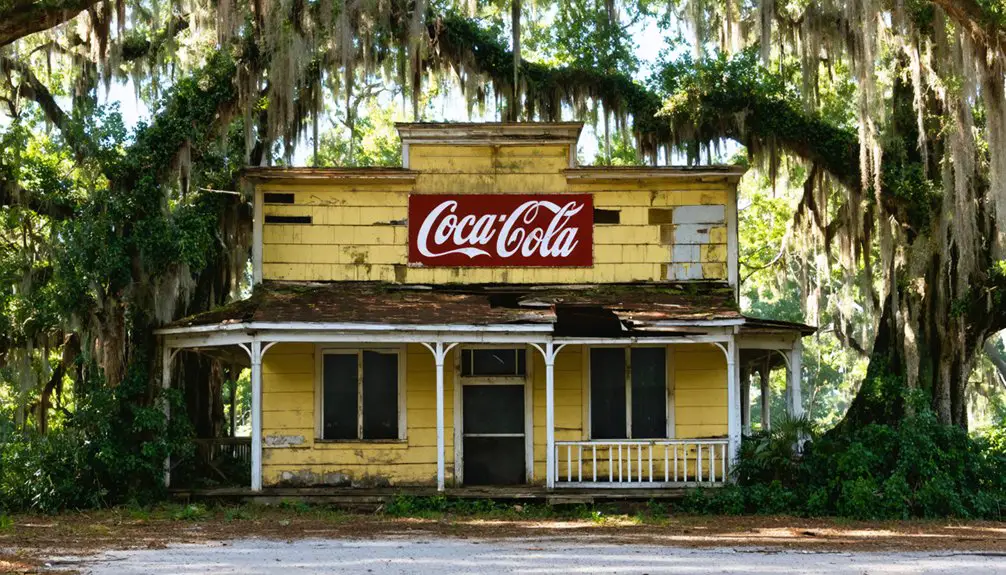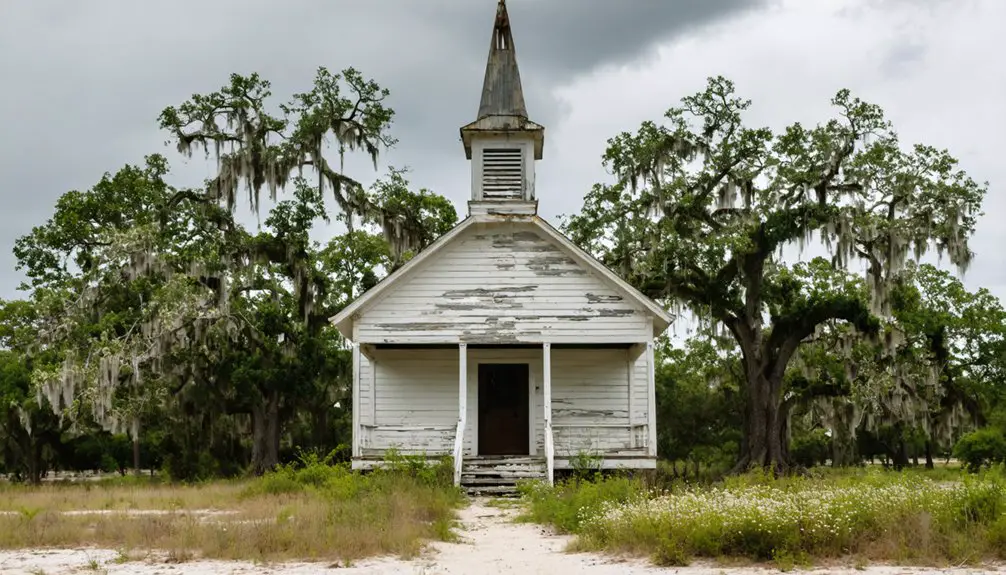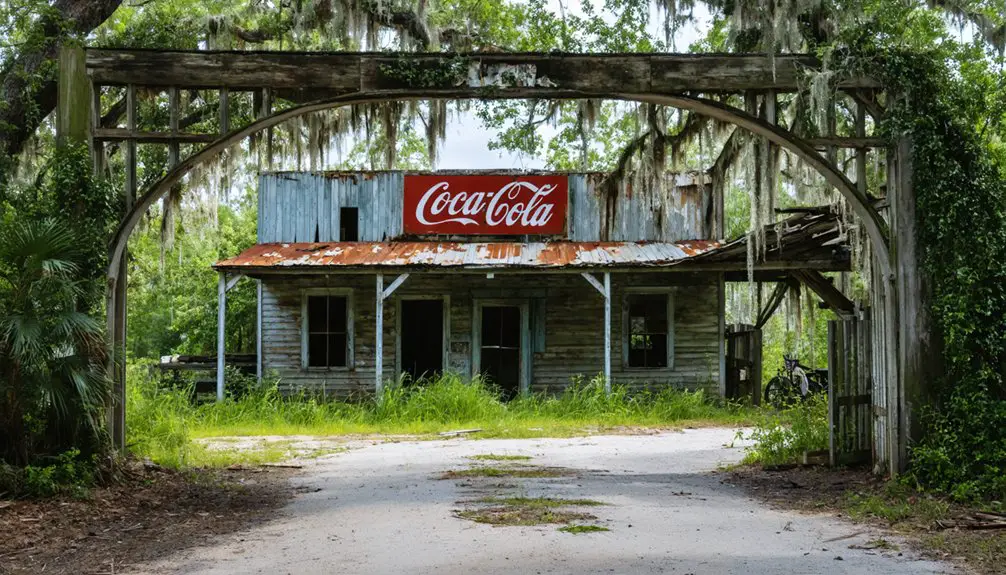You’ll find Island Grove tucked away in north-central Florida, where a once-bustling agricultural town of 400 residents thrived in the 1880s. The arrival of railroads transformed this waterbound settlement into a crucial shipping hub for citrus and produce. After the devastating Great Freeze of 1894-1895 sent temperatures plunging to 11°F, the town’s prosperity withered. Today, abandoned structures and a working winery offer glimpses into this ghost town’s fascinating past.
Key Takeaways
- Island Grove transformed from a thriving 400-resident agricultural community into a ghost town after the devastating Great Freeze of 1894-1895.
- The town’s decline accelerated when citrus groves were destroyed and land values plummeted from $1,000 to $10 per acre.
- Major institutions closed over time, including the Methodist Church’s final service in 1972, marking the community’s fading existence.
- Today, only sparse physical evidence remains of the once-bustling railroad hub, including abandoned structures and a working winery.
- Population migration occurred as residents left the isolated community following economic hardships and diminishing railroad connections.
The Birth of a Waterbound Settlement
While many Florida settlements emerged along coastal areas in the late 19th century, Island Grove took root in 1882 within north-central Florida’s distinctive inland waterscape.
You’ll find this waterbound settlement was aptly named – nearly encircled by swamps, lakes, and creeks, creating a unique island-like environment that shaped its destiny.
W.J. Moore founded the community and established its first post office in 1884, launching a hub that would grow to 400 residents at its peak.
The town’s geographic isolation actually spawned opportunity, with locals capitalizing on the fertile grounds for farming and abundant waters for fishing.
The Florida Railway & Navigation Co. and Peninsular Railroad became lifelines, connecting this water-surrounded community to crucial shipping routes for its thriving fruit and vegetable trade.
The turpentine industry became a significant economic driver for the community, as evidenced by the catfaced pine trees still visible in the surrounding woods.
The bustling community grew to include two churches, a school, a grocery store, and a Masonic Lodge during its most prosperous years.
Early Days of Railroad Prosperity
You’ll find Island Grove’s early railroad expansion was marked by the Florida Railway & Navigation Company and Peninsular Railroad lines, which transformed this water-bound community into a crucial transportation hub.
These railways connected Island Grove to major Florida cities and enabled the town’s fruit growers, including G.R. Fairbanks and the Blake brothers, to ship their produce efficiently through the local packing plant. The line became part of the Florida Central and Peninsular through key railroad mergers in 1886.
The railroad’s arrival spurred the development of essential infrastructure, as you’d expect, with a post office established by W.J. Moore in 1884, followed by churches, schools, and a Masonic Lodge that served the growing population of 400 residents. The town’s agricultural roots helped establish its significance in Florida’s early development.
Railroad Growth Spurs Commerce
As railroad tracks stretched across Florida in the 1880s, Island Grove emerged as a bustling commercial hub, founded by W.J. Moore. The town’s economic transformation became evident as railroads connected this once-isolated community to broader markets. Following Henry Flagler’s vision, the expanding rail network helped establish vital transportation corridors throughout the state. This development paralleled the growth happening in cities like Palm Beach, which started from humble beginnings.
You’d find the Florida Railway & Navigation Co. and Peninsular Railroad driving unprecedented growth in local commerce.
Consider these key developments that shaped Island Grove’s prosperity:
- A major packing plant arose alongside the railroad tracks, processing fruit from surrounding groves.
- Land grants of 8,000 acres per mile incentivized railroad expansion, creating new opportunities for trade.
- Local growers like G.R. Fairbanks and J. Adger Clark capitalized on rail access to ship their produce to distant markets.
The railroad’s presence transformed Island Grove into a thriving agricultural shipping point with a population of 400.
Railroads Connect Florida Peninsula
The expansion of Florida’s railroad network in the mid-1800s transformed the peninsula’s transportation landscape. You’d find the Florida Railroad stretching 156 miles from Fernandina to Cedar Key by 1861, creating essential railroad connectivity between the Atlantic and Gulf coasts while saving 800 miles of dangerous sea travel around the peninsula.
Through strategic development by figures like David Levy Yulee and Edward Dickerson’s investment syndicate, the railways fostered economic integration across previously isolated regions. Towns like Callahan, Baldwin, and Waldo sprang up along the routes, while existing centers gained new commercial opportunities. The 5ft gauge line established in 1853 by the Florida Legislature became the foundation for this ambitious transportation project. Wealthy winter tourists began flocking to Florida once the railroads provided comfortable access to the state.
The railroad system’s growth integrated Florida’s agriculture, shipping, and tourism sectors by connecting inland farms to coastal ports. Despite financial challenges like the 1857 Panic, these early railroads laid the foundation for Florida’s transportation future.
A Thriving Agricultural Community
During Island Grove’s peak, you’d find the area bustling with citrus operations, as prominent families like the Fairbanks, Adgers, and Blakes owned extensive groves that produced fruit for regional markets.
Today, Island Grove’s agricultural legacy continues through a 200-acre organic farm that maintains sustainable blueberry production while preserving the surrounding natural habitat.
You could watch workers at the local packing plants preparing citrus and other crops for shipment via the Florida Railway & Navigation Co. and Peninsular Railroad lines that served the town.
The railroad hub’s success meant Island Grove farmers weren’t limited by their remote location, allowing them to efficiently transport their harvests to distant markets despite being surrounded by swamps and waterways.
Citrus Growing and Shipping
While Spanish explorers first introduced citrus to Florida between 1513-1565, Island Grove’s commercial growing operations wouldn’t emerge until the 1800s, when improved transportation enabled wider distribution of this non-native crop.
You’d find the region’s sandy, alkaline soil perfect for cultivating various citrus varieties, with consistent water supply supporting quality fruit development.
Douglas Dummett’s development of topworking techniques on Merritt Island revolutionized the industry. The area’s citrus industry thrived thanks to these key innovations:
- Topworking techniques that grafted sweet varieties onto hardy rootstock
- Steamboat transport that opened northern markets to Florida citrus
- Refrigerated railcars that revolutionized long-distance shipping
Like many Florida communities, Island Grove’s growers faced challenges from freezes and fruit fly infestations, but shipping advances and agricultural expertise helped sustain the industry’s growth through the late 1800s.
Railroad Hub Success
As citrus production expanded throughout north-central Florida, Island Grove’s establishment in 1882 marked a defining moment in the region’s agricultural development.
You’d have found the town thriving as a strategic railroad hub, served by both the Florida Railway & Navigation Company and the Peninsular Railroad, which connected local farmers to distant markets.
The railroad impact transformed Island Grove into a bustling center of commerce, where a population of 400 residents prospered from the railway’s ability to ship their agricultural goods efficiently.
At the heart of this success stood a packing plant along the railroad, processing crops from surrounding farms and groves.
Despite eventual connectivity issues as newer transportation routes emerged elsewhere, Island Grove’s early railroad connections proved essential to its peak era of agricultural prosperity.
Religious and Social Institutions
Religious and social institutions formed the backbone of Island Grove’s community life when the town flourished in the late 1800s and early 1900s.
You’d find a tight-knit church community centered around the Methodist Church, established in 1885, where farmers, fishermen, and citrus growers gathered for both worship and social gatherings.
The town’s social fabric was woven through three key institutions:
The heart of Island Grove beat through its trinity of pillars: church, lodge, and schoolhouse – each thread binding neighbors together.
- The Methodist Church, which served as the spiritual center until 1972
- The Masonic Lodge, established in 1924, providing a crucial social hub
- The public school, which doubled as a community meeting space
These institutions reflected Island Grove’s vitality until economic hardships and harsh winters drove residents away.
Today, you’ll find only remnants – the collapsed church ruins and the Lodge building, now serving as a fire station.
Economic Peak and Notable Landmarks

During its economic peak in the late 1800s, Island Grove thrived as a bustling agricultural hub with nearly 400 residents. The town’s economic significance centered around its large packing plant, which connected directly to the Florida Railway & Navigation Co. and Peninsular Railroad lines, enabling efficient fruit shipment from the region’s expansive groves.
You’d have found several notable community landmarks dotting the landscape, including two prominent churches – Baptist and Methodist – that served as essential social centers.
The post office, established in 1884, stood as another key gathering spot, while the Masonic Lodge fostered community bonds.
Major fruit groves owned by entrepreneurs like G.R. Fairbanks and J. Adger dominated the area, alongside a unique winery that showcased the town’s agricultural diversity.
The Great Freeze and Natural Challenges
The devastating Great Freeze of 1894-1895 dealt Island Grove’s thriving citrus industry a fatal blow, plunging temperatures to a bone-chilling 18°F in December and an even more severe 11°F in February.
The environmental impact was catastrophic, destroying not just the season’s fruit but killing many established trees down to their roots.
The Great Freeze’s destruction manifested in three primary ways:
- Land values plummeted from $1,000 to just $10 per acre
- Fish and turtles died en masse along local waterways
- Clouds of vapor rose from rivers as extreme temperature differences created an eerie, apocalyptic scene
You’ll find that many small growers couldn’t afford to replant and wait seven years for new trees to produce fruit, leading to Island Grove’s eventual abandonment as a citrus center.
Decline of a Once-Bustling Town

As Island Grove reeled from the devastating Great Freeze, its decline accelerated through a perfect storm of economic and transportation challenges.
You’d have seen the town’s lifeline – its railroad connections – gradually fade away, leading to economic isolation that choked off trade routes for local farmers and merchants.
The town’s position off major interstate highways sealed its fate. You could’ve witnessed the population migration as residents sought opportunities elsewhere, leaving behind empty storefronts and quiet streets.
The once-thriving community of 400 dwindled as its packing plant closed, farms struggled, and crucial institutions shuttered their doors.
Even the Methodist Church, which had served the faithful since 1885, held its final service in 1972.
Today, the collapsed buildings and overgrown lots tell the story of a bustling town that time forgot.
Remnants and Modern Repurposing
Modern visitors to Island Grove will find sparse physical evidence of its once-thriving community, with most structures having succumbed to time and neglect.
You’ll discover abandoned structures scattered across the landscape, with the Methodist Church’s 2021 collapse marking the loss of one of the area’s last significant landmarks. Community memories live on through historical photographs and documentation by local interest groups.
Today’s landscape reveals:
- Scattered foundations and deteriorating building materials from former homes and community buildings
- A working winery that represents the only active commercial enterprise within the ghost town’s boundaries
- Rural, wooded terrain dotted with private homesteads where communal spaces once existed
The site’s remote location has preserved its abandoned character, making it a destination for historians and explorers seeking glimpses into Florida’s rural past.
Historical Legacy in Central Florida

Standing as a symbol of Florida’s post-Civil War development, Island Grove exemplifies the rise and fall of small agricultural communities that once dotted the state’s rural landscape.
You’ll find its cultural impact woven into the fabric of central Florida’s history, where railroads and agriculture shaped settlement patterns throughout Marion and Alachua counties.
The town’s community resilience showed through its churches, Masonic Lodge, and schools – institutions that formed the backbone of rural life in the late 1800s.
While harsh winters and changing transportation patterns eventually led to Island Grove’s decline, you can still trace the region’s agricultural heritage through its story.
The town remains a powerful reminder of how small communities adapted to Florida’s evolving economic and social landscape.
Frequently Asked Questions
Are There Any Known Ghost Stories or Paranormal Activities in Island Grove?
Like a blank canvas, you won’t find documented ghost sightings or haunted locations in Island Grove. Despite its eerie abandoned buildings, no credible paranormal activities have been formally reported here.
What Was the Highest Recorded Population in Island Grove’s History?
You’ll find the highest recorded population was 400 residents during Island Grove’s historical significance in the late 19th and early 20th centuries, before its dramatic population decline due to economic shifts.
Did Any Famous People Besides Marjorie Kinnan Rawlings Live in Island Grove?
Like branches on a family tree, you’ll find historical figures Terry Hadley III, Dr. James Bishop, Zelma Cason, and William Dupree among Island Grove’s famous residents alongside Thomas and Serena Haile.
What Were the Average Property Values During Island Grove’s Peak Years?
You can’t know exact property values since no direct records exist, but economic factors like agriculture and railroad access suggest modest property trends during Island Grove’s 1882-1930s peak years.
Were There Any Significant Crimes or Notable Law Enforcement Incidents Recorded?
You won’t find documented evidence of significant crimes or notable law enforcement incidents in the historical record. The town’s small rural setting suggests minimal formal policing was needed during its peak years.
References
- http://www.desolationflorida.com/2016/07/island-grove.html
- https://www.tampabay.com/archive/2002/08/10/towns-of-kerr-city-island-grove-recall-a-state-of-florida-that-was/
- https://theforgottensouth.com/abandoned-island-grove-alachua-florida-church/
- https://www.youtube.com/watch?v=rMRJqCEJxbA
- https://www.youtube.com/watch?v=1kGlzMHmXx0
- https://www.miami-history.com/p/early-stirrings-in-coconut-grove
- https://clayclerk.com/historical-archives/county-history/location-place/towns-settlements/
- https://alachuacounty.us/Govt/pages/alachuacountyhistory.aspx
- https://en.wikipedia.org/wiki/Florida_Central_and_Peninsular_Railroad
- https://en.wikipedia.org/wiki/Florida_East_Coast_Railway



